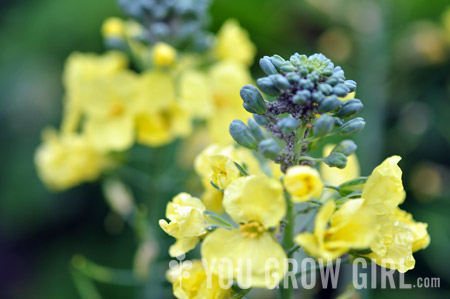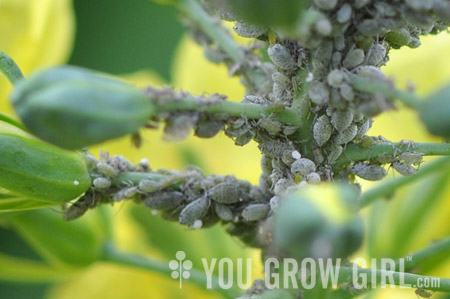
The reality of leaving the garden during the growing season is that you will come home to some small or large disaster. You roll with the punches, accept the losses, or you never leave home. I love my garden, but since travel is a part of my job (and one that I enjoy), I have had to do some adept rolling as well as learn a bit of acceptance along the way. I also try to plan my trips for cooler parts of the season when my constant attention is unneccessary.
I have just returned from a trip to Georgia to an aphid infestation of epic proportions on two of my Spigarello plants. Of course, they are my favourite two. The prettiest two. The two I am allowing to bolt so I can harvest seed. Were this a Sophie’s Choice situation I would say without hesitation, “Take the ones at the back of the garden. Heck, take ALL OF the kale if you must. We’re pretty much sick of it anyways.”
But no. Alas, we gardeners do not get to choose which plants the pests will descend upon. And often times they want the very plants we want to keep most. That is how it goes. I have loads of nasturtiums in my garden right now (a known aphid attractant), and amazingly enough they are completely unscathed. Nary an aphid in sight.

Were I not trying to save seed from these plants and if the TV crew were not going to be here next week to shoot a segment that involves these plants, I would simply cut them back hard and call it a day. I would wash the aphids off in soapy water in the sink and freeze the leaves for winter storage.
However, due to the reasons above I have had to resort to plan B: Hose that thing down daily and squish aphids between my fingers until I’m dead on the inside.
Inevitably, whenever I travel to speak, someone or several someones in the audience will ask about how to deal with pests. There is a long answer, which involves striving for balance and a diversity of plants and insects in the garden, taking very good care of the soil, and practicing good cultivation techniques that will keep plants healthy and resilient to pestilence. But under time pressure I do not have time to explain the long answer. I have a minute tops to explain, so I usually skip straight to the short answer: squish them. Barriers/preventative measures work for some pests, too.
We want shortcuts, but there aren’t any that don’t involve sprays and/or chemicals. Over the years, I have cut out sprays save for an homemade herbal concoction. I only pull out the soapy spray on indoor plants during the desperate winter months. The reality is that where there are plants, there will be pests. It happens under the very best of circumstances to the very best gardeners. Aphids love brassicas and they are born pregnant. That’s a fighting strategy that is hard to beat.
The key to the water spray/squish method is persistence. Do not wait a day or so between sessions. Do not leave any crack or crevice unattended. This works, but it does take a time commitment that we don’t always have.
———-
P.S. If you’d like to learn more about growing Spigarello and other Brassicas, I have an article on the topic in the current issue (Fall 2011) of Garden Making magazine. There is also a good chunk on the topic in Grow Great Grub.
Gonna Google for it when I have a moment, but do you have a preferred source for Spiragarello seeds?
Thanks for posting this. Several weeks ago, I also wrote about aphids and some of our efforts battling it, that includes ladybugs, neem oil, etc.
The infestation would die down, but they would be back again. And at the end of the day we would simply cut ’em like how you’d do it.
I thank you, because it gives me comfort knowing that aphids also visit someone with an extensive experience as you are, and that what you do and your sound advices are the direction that we are going.
{But I probably wouldn’t dare myself to squeeze ’em though..I’ll ask my hubby to do it…:P}
I’ve been lucky to find local sources for transplants in the spring (my first year plants were transplants) and an italian grocer sells the seeds.
We grew up always having to soak the broccoli in salty water before cooking to see what comes to the top — or turning a blind eye afterwards. It’s kind of scary that supermarket broc comes aphid-free.
I use my hose on jet to blast them off about once a week. the brassicas generally seem hardy enough to stand that.
never saw success with the water or the detergent/water spray combo with aphids when it comes to my roses. the only thing, which i discovered at a gardening class, that works pretty consistently for me, is tomato leaf spray (literally soaking a big handful of tomato leaves in a pitcher of water for a few hours before pouring into a spray thingy). just make sure to use it all up otherwise moldy tomato leaf water is gnarly :)
We’re just coming into aphid season here. How do they know the plants which are our favourites? I planted some sacrificial almond trees to save the rest of the orchard. Guess what? Mine must be the only garden the birds have ignored the almonds in – and yep, they’ve gone for my favourites, the quinces aaaagh.
hmmm, looks like my kale right now. it’s a very senior kale, and there’s no TV crew coming, so it’ll get cut asap. I’m amazed at your aphid-free nasturtiums. the margins of our yard are choked with wild/escaped nasturtiums, and they get so coated with aphids it’s astounding and a little disgusting.
My nasturtiums are strangely untouched by aphids this year too. The japanese beetles on the soybeans are a whole other story…
I appreciate your squishing advice. Squeamishness has no place in the organic garden (or kitchen). Pop a bug and feel the power ;)
I had a lot of luck with ladybugs this year. I had 1 Dahlia & 1 broccoli plant seriously infested in my community garden. I put a box of ladybugs in their overnight and have been aphid free for about a month now…